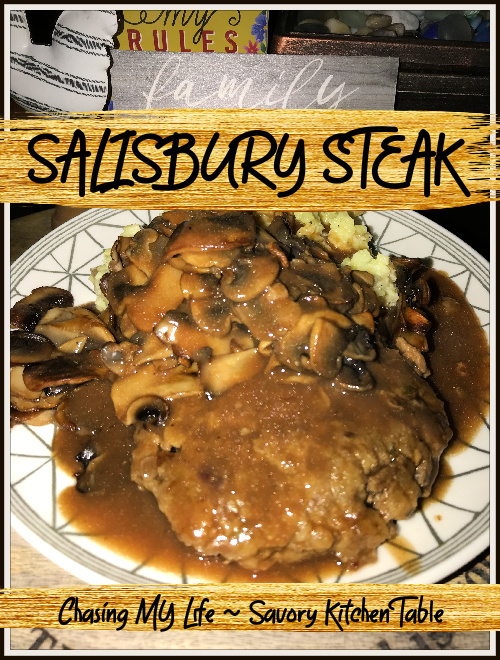There is nothing quite as satisfying as a plate of classic home cooked scratch made Salisbury Steak, with the favorite stick-to-your-ribs side dishes like glazed carrots, and mashed potatoes with thick beef gravy poured on top – a throwback to TV dinners, but oh so much better, on the table quickly and completely family friendly.
Salisbury steak originates in the United States and is made from a blend of ground beef and ground pork with onions and seasonings and is considered a version of Hamburg steak.
The Interesting History Behind Satisfying Salisbury Steak as per MIAMI BEEF
“A Close Cousin to the Hamburger – Like the name implies, we have Hamburg Germany to thank for the popularization of the hamburger patty. In the late 19th century, sailors from German brought the delicious meal to the Port of New York, where the minced beef was smoked, lightly salted and then served along with onions and breadcrumbs as a quick hearty meal. In 1873, historians say that you could buy a plate of Hamburg steak with all the toppings for about 11 cents.
Today, some people wince at the idea of having a hamburger for breakfast, but the truth is that in the late 1800’s it was the protein of choice to start your day. In fact, it was such a popular health food, that hospitals even served it to patients raw or slightly cooked, with a raw egg. Which doesn’t sound appetizing compared to our contemporary tastes, but it was a vitamin and protein rich meal at a time when proteins were both expensive to purchase, as well as difficult and time consuming to cook.
Why Is It Called ‘Salisbury Steak’ and Who Is It Named After? Did you know that Salisbury Steak got its start as a famous food in America, when it was used as stand-by high-protein meals for soldiers during the American Civil War? It makes sense, when you think about it, because of the nutritional content of the meat and the fast preparation time. Not to mention that for American soldiers fighting through cold weather, it was a taste of home and comfort food during some pretty difficult conditions.
A physician named Dr. James Henry Salisbury was an early dietician and studied gastrointestinal health, digestion and nutrition in the mid 1800s. One of the most serious threats to American soldiers during the Civil War was wasting, due to malnutrition, and symptoms of chronic diarrhea. Dr. Salisbury was convinced that while other types of food like soup and bread, and some fruits and vegetables were provided to the soldiers, it was really protein (and specifically beef) that they needed to stay healthy.
The challenge was cooking and preparing meat for the troops, as well as the increased costs of providing high-protein meals for them. Toward the middle and end of the American Civil War, soldiers were looting communities in search of food, given the shortage of funds to supply the advancing soldiers (on both sides).
Soldiers were traditionally provided with ‘soldier biscuits’ which were dried, and which contained some fortified vegetable and fruits, but the high yeast content and the low protein content of the biscuits began to create disease. Wounded soldiers that were nutritionally famished, didn’t heal quickly to return to active duty, and the Northern and Southern American armies were forced to start addressing the nutrition they provided to their troops (or lose the war).
During the American Civil War, Dr. Salisbury tested his theory by providing “chopped beef” which was a little easier to digest for soldiers than root vegetables and other protein sources. After the war, he wrote a book called “The Relation of Alimentation and Disease” which could be one of the first real diet trending publications, that helped people understand the link between health and a balanced diet, which included animal proteins rich in B vitamins.
Dr. James Henry Salisbury was also one of the first physicians to indicate that animal fats were necessary for metabolic health; something that contemporary nutritionists have embraced again, after a long-time social moratorium on animal fats.
American Quality Standards for Salisbury Steak – Salisbury steak as a product, can be a mix of different proteins. Per the United States Department of Agriculture standards, Salisbury steak must have a minimum meat content of 65%, and up to 25% of that can be derived from pork. If the pork meat is de-fatted, the limit is 12% pork meat in the constitution of the Salisbury steak. No more than 30% of the Salisbury steak can be fat.
Extenders or fillers can be used in Salisbury steak, which also help to reduce the cooking time in this fast-preparation protein, however meat by-products are not permitted. Extenders may include bread crumbs, flour or oat flakes, but the limit for approved fillers is not to exceed 12% of the product volume. Soy proteins may be added but are limited to 6.8% or less by finished product volume.
The rest is a proprietary blend that depends on the processor, and that is where much of the flavor is unique and innovated to specification for commercial clients. Special seasonings, and the addition of fresh vegetables such as onion, mushrooms or sweet peppers may be added, along with binding ingredients such as eggs, cream, buttermilk, water, vinegar or brine.
To be labeled as Salisbury steak, the product must be completely cooked. It may not be called “hamburger patties” if it contains a blend of animal proteins and fats. So, while you may think a Salisbury steak is just a burger with gravy on it, there is a distinctly different recipe and food standards behind it. Most of the standards mentioned apply only to Salisbury steak produced in USDA Inspected meat processing facilities; other products may not carry the USDA inspection label. Salisbury steak must be pre-cooked prior to being frozen, or the product label must state “Patties for Salisbury Steak”.
Add Salisbury Steak to Your Menu – The classic flavors of tender beef, or a blend of pork and beef is rich and satisfying. When combined with the American favorite side-dish of mashed potatoes and gravy? You have the perfect comfort food, and Salisbury steak fits on just about any scratch or fast-casual menu. It is also popular for pubs and bars, as an economical lunch special.”

SALISBURY STEAK
STEAKS
1 pound lean ground beef
1/4 cup panko breadcrumbs
1 LARGE egg , beaten
2 teaspoons ketchup
1 teaspoon Dijon mustard
1/2 teaspoon dried oregano
FRESH ground sea salt and black pepper, to taste
1 tablespoon avocado oil
- In a large bowl, combine all the ingredients for the steaks except the oil until combined, but do not overwork.
- Shape the mixture into equal oval patties, about 3/4-inch thick.
- In a large nonstick skillet, warm the oil over medium+ heat; add the steaks and cook 2-3 minutes per side until you have a nice golden crust.
- Transfer to a plate.
GRAVY
2 tablespoons unsalted butter
2 tablespoons WONDRA flour
1 1/2 cups beef stock
1 tablespoon ketchup
1 teaspoon Worcestershire sauce
1/2 teaspoon onion powder
6 ounces sliced cremini mushrooms
FRESH ground sea salt and pepper, to taste
- Reduce the heat to medium in the skillet.
- Add the butter to the drippings.
- Whisk in flour until combined and lump free.
- Reduce heat to medium-low and add in the beef stock, whisking well.
- Add in the ketchup, Worcestershire, onion powder, whisking to combine.
- Add in the mushrooms, simmering for 4-5 minutes to thicken.
- Season with salt and pepper, to taste.
- Add the partially cooked steaks back to the skillet and nestle into the gravy; cover and cook another 10 minutes until cooked through.
- Serve steaks with mashed potatoes and mushroom gravy drizzled on top.



